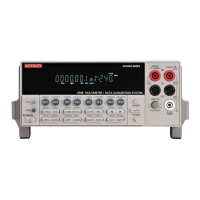Performance Verification 1-7
Test considerations
When performing the verification procedures:
• Be sure to restore factory defaults as outlined above.
• Make sure that the equipment is properly warmed up and connected to the correct input
terminals. Also make sure that the INPUTS switch is in the correct position.
• Do not use autoranging for any verification tests because autorange hysteresis may
cause the Model 2700 to be on an incorrect range. For each test signal, you must manu-
ally set the correct range for the Model 2700 using the range keys.
• Make sure the calibrator is in operate before you verify each measurement.
• Always let the source signal settle before taking a reading.
WARNING
Observe the following safety precautions when performing these tests:
•
Some of the procedures in this section may expose you to dangerous
voltages. Use standard safety precautions when such dangerous volt-
ages are encountered to avoid personal injury or death caused by elec-
tric shock.
•
For the front panel terminals only, the maximum common-mode volt-
age (voltage between INPUT LO and chassis ground) is 500V peak.
Exceeding this value may cause a breakdown in insulation, creating a
shock hazard.
•
For the plug-in modules, the maximum common-mode voltage (volt-
age between any plug-in module terminal and chassis ground) is 300V
DC or 300V RMS. Exceeding this value may cause a breakdown in
insulation, creating a shock hazard.
•
When using the front panel terminals simultaneously with plug-in
modules, all cable insulation voltage ratings must equal or exceed the
maximum voltage applied to either the front panel terminals or the
plug-in module terminals.

